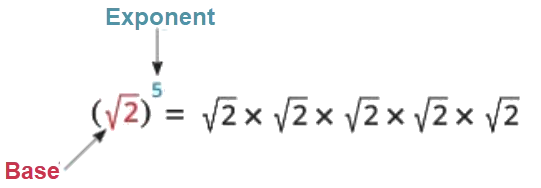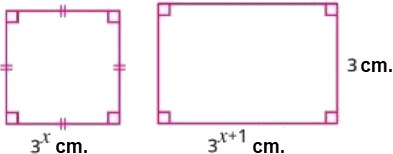📖 Learn!
📚 Repeated Multiplication in the Set of Real Numbers
The mathematical expression \(a^n\) is used to represent the product of multiplying the real number \(a\) by itself \(n\) times.

For example:

📝 Example (1)
Find the value of each of the following:
Solution
Zero and Negative Exponents
The Zero Exponent
Any non-zero real number raised to the power of zero equals 1.
\( a^0 = 1 \), where \( a \in \mathbb{R}^* \)
Examples: \( 5^0 = 1 \), \( (\sqrt{3})^0 = 1 \), \( (-\sqrt[3]{4})^0 = 1 \)
The Negative Exponent
For any non-zero real number \( a \) and a positive integer \( n \), the expression \( a^{-n} \) is the multiplicative inverse of \( a^n \).
\( a^{-n} = \frac{1}{a^n} \), where \( a \in \mathbb{R}^* \), \( n \in \mathbb{Z}^+ \)
Examples:
\( (\sqrt{3})^{-4} = \frac{1}{(\sqrt{3})^4} = \frac{1}{9} \)
\( (\frac{1}{\sqrt[3]{4}})^{-3} = (\sqrt[3]{4})^3 = 4 \)
Important Note
-
💡
Division by Zero
Division by zero is undefined. Therefore, when symbols are present in the denominator, it is a condition that these symbols must not equal zero.
This means for any expression of the form $\frac{X}{Y}$, $Y \neq 0$.
Laws of Multiplication
Rule 1: Product of Powers with the Same Base
When multiplying powers with the same base, keep the base and add the exponents. For any real number \(a \in \mathbb{R}\) and integers \(m, n \in \mathbb{Z}\):
\( a^m \times a^n = a^{m+n} \)
Examples:
- \( 2^4 \times 2^6 = 2^{4+6} = 2^{10} \)
- \( a^{-3} \times a^5 = a^{-3+5} = a^2 \)
Rule 2: Power of a Product
When finding the power of a product of two numbers, distribute the exponent to each number. For any real numbers \(a, b \in \mathbb{R}\) and integer \(n \in \mathbb{Z}\):
\( (a \times b)^n = a^n \times b^n \)
Example:
- \( (3\sqrt{2})^2 = 3^2 \times (\sqrt{2})^2 = 9 \times 2 = 18 \)
Important Note: Sum/Difference of Powers
It is important to remember that the exponent cannot be distributed over addition or subtraction:
- ⚠️ \( (a+b)^n \neq a^n + b^n \)
- ⚠️ \( (a-b)^n \neq a^n - b^n \)
Laws of Division
Rule 1: Quotient of Powers with the Same Base
When dividing powers with the same base, keep the base and subtract the exponents. For any non-zero real number \(a \in \mathbb{R}^*\) and integers \(m, n \in \mathbb{Z}\):
\( \frac{a^m}{a^n} = a^{m-n} \)
Example:
- \( \frac{(\sqrt{7})^5}{(\sqrt{7})^2} = (\sqrt{7})^{5-2} = (\sqrt{7})^3 = 7\sqrt{7} \)
Rule 2: Power of a Quotient
When finding the power of a quotient of two numbers, distribute the exponent to both the numerator and the denominator. For any real number \(a \in \mathbb{R}\), non-zero real number \(b \in \mathbb{R}^*\), and integer \(n \in \mathbb{Z}\):
\( (\frac{a}{b})^n = \frac{a^n}{b^n} \)
Example:
- \( (\frac{6}{\sqrt{3}})^2 = \frac{6^2}{(\sqrt{3})^2} = \frac{36}{3} = 12 \)
📝 Example (2)
Simplify each of the following to its simplest form:
Solution
📝 Example (3)
Simplify each of the following to its simplest form, then find the numerical value for the given value of \(n\):
Solution
When \(n=1\):
\( \therefore (\sqrt{3})^{2(1)-1} = (\sqrt{3})^{2-1} = \sqrt{3} \)When \(n=2\):
\( \therefore 10^{3(2)-6} = 10^{6-6} = 10^0 = 1 \)When \(n=-2\):
\( \therefore 5^{-2} = \frac{1}{5^2} = \frac{1}{25} \)There is no specific value of \(n\) given for this problem, so the simplified form is \(10^{-n}\).
📝 Example (4)
In the opposite figure:

- A square with side length \(3^x\) cm.
- A rectangle with dimensions \(3^{x+1}\) cm and \(3\) cm.
If the perimeter of the square is 20 cm, then find the area of the rectangle.
Solution
Perimeter of the square \( = 20 \) cm
\( \therefore 4 \times 3^x = 20 \) \( \therefore 3^x = \frac{20}{4} = 5 \)Area of the rectangle \(A = \text{Length} \times \text{Width}\)
\( \therefore A = 3^{x+1} \times 3^x \) \( = 3^{x+1+x} = 3^{2x+1} \) \( = 3^{2x} \times 3^1 \) \( = (3^x)^2 \times 3 \) \( = (5)^2 \times 3 \) (Substitute \(3^x=5\)) \( = 25 \times 3 \) \( = 75 \)Area of the rectangle \( = 75 \text{ cm}^2 \)
📝 Example (5)
If \(3^x = 4\), then find the numerical value for each of the following:
Solution
📝 Example (6)
Choose the correct answer from the given options:
a \( a^3 \)
b \( \frac{a}{b} \)
c \( \frac{a^3}{b^2} \)
d \( \frac{a^2}{b^3} \)
a \( 0 \)
b \( 6 \)
c \( 1 \)
d \( -6 \)
a \( \sqrt{3} \)
b \( \frac{\sqrt{3}}{3} \)
c \( 3 \)
d \( \frac{1}{3} \)
a \( 5\sqrt{2} \)
b \( 5\sqrt{2} \)
c \( \frac{5}{\sqrt{10}} \)
d \( 2 \)
a \( a^4 \text{ cm} \)
b \( (\sqrt{a})^4 \text{ cm} \)
c \( 4\sqrt{a} \text{ cm} \)
d \( 4a^2 \text{ cm} \)
a \( 4^2 \)
b \( 4^3 \)
c \( 4^8 \)
d \( 4^{16} \)
a \( 0 \)
b \( 1 \)
c \( -1 \)
d \( -2 \)
a \( 0 \)
b \( 1 \)
c \( -1 \)
d \( -2 \)
a \( 5 \)
b \( \sqrt[3]{5} \)
c \( (\sqrt{5})^8 \)
d \( 25 \)
a \( 4 \)
b \( 5 \)
c \( 6 \)
d \( 9 \)
Solution
Correct option: (a) \( a^3 \)
Correct option: (c) \( 1 \)
Correct option: (b) \( \frac{\sqrt{3}}{3} \)
Correct option: (a) \( 5\sqrt{2} \)
Correct option: (d) \( 4a^2 \text{ cm} \)
Correct option: (b) \( 4^3 \)
Correct option: (b) \( 1 \)
Correct option: (a) \( 0 \)
Correct option: (d) \( 25 \)
Correct option: (c) \( 6 \)
